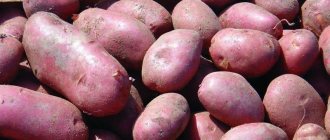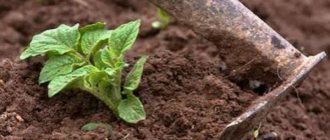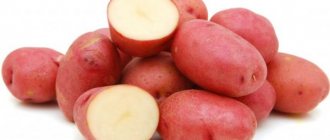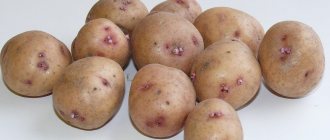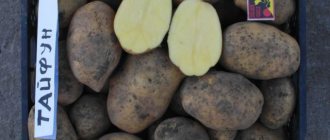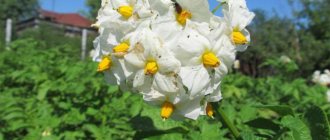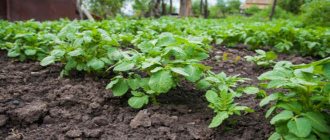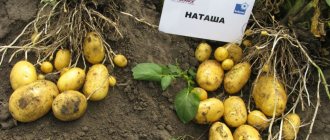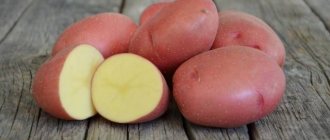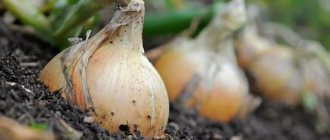Description of the variety
Slavyanka is a mid-season table variety. After the tubers hit the soil and before harvesting, 100-120 days pass.
The variety is high-yielding. On an industrial scale, entrepreneurs often manage to achieve figures of 300-330 centners per hectare. At home you can easily expect 180-280 c/ha.
The variety is unpretentious in care. The only problem when growing it can be poor soil. If the soil is not fertilized enough, then you will not be able to get a good harvest, even with hilling and watering. Otherwise, the variety is completely unpretentious.
Has relatively good immunity. Slavyanka is protected from diseases such as potato cancer, leaf mosaic and the virus that causes leaf curl. Also, potato tubers are rarely affected by a parasite such as a nematode.
Main characteristics and description of Slavyanka potatoes
The Slavyanka potato variety is a mid-season variety - no more than 4 months pass from planting to harvesting. The tubers are smooth and approximately the same size; their weight can be 100-240 g.
Potato Slavyanka video
From one bush you can collect up to 15 tubers. The peel is smooth, the eyes are almost invisible, its color is red, the flesh is dense, cream-colored, with a starch content of about 12%. The tubers contain a large amount of B vitamins, amino acids, and protein.
The tops are medium in size, there are many shoots. The foliage is medium in size, typically potato-like, emerald in color.
The taste of the tubers is good; root vegetables are suitable for frying and making salads.
Good variety of potatoes!
• ZHUKOVSKY • KREPISH • JEWEL
Potato yield Slavyanka
The yield of Slavyanka potatoes is high - from 1 m2 you can harvest 25-30 kg, and with good care - up to 40 kg.
Another advantage of this potato is the good keeping quality of the tubers; they are usually stored in the cellar for the whole winter, while the taste and presentation practically do not deteriorate.
Potato Slavyanka is highly resistant to the following diseases:
- golden potato nematode;
- pathogen of potato cancer;
- wrinkled and striped mosaic;
- leafroll virus.
Interesting article:
The drug “Prestige” for the Colorado potato beetle
Description of tubers
This variety is excellent for growing for sale. Firstly, tubers can reach incredible sizes up to 250 g. On average, root crops smaller than 90 g are very rare.
Secondly, Slavyanka is well stored. The keeping quality of the variety reaches 95%.
The tuber has a red shell. The flesh is cream-colored. The starch content in the fruit is in the range of 11-13%. That is, potatoes do not become overcooked even with prolonged heat treatments. Ideal for frying, making fries or soups.
Features of cultivation
The Slavyanka variety is unpretentious and can easily adapt to changes in weather conditions and to almost any soil. But it is an intensive type variety, therefore, in order to obtain record yields, it requires regular and increased feeding.
Important! The variety has the unique ability not to degenerate during long-term cultivation and not to accumulate nitrates in the fruits.
It must be planted in heated soil with a distance between bushes of 35 cm. It is advisable to leave the row spacing at least 70-75 cm. For irrigation, it is ideal to use drip irrigation, however, the Slavyanka variety is characterized by resistance to short-term drought.
Given the increased sensitivity of the variety to mechanical damage, it is necessary to dig up tubers with great care. The tubers are stored almost until spring without losing their qualities.
Description of the bush
The bushes are small, medium in size. Spreading is present, but relatively unnoticeable. Leaves cover the stems abundantly. They are large in size, lightly pubescent, and dark green in color.
The inflorescences form several berries. The flowers themselves are bluish-violet with pure white tips.
The root system is well developed. One bush produces from 12 to 15 large root crops. The amount of “peas” is within the minimum.
Slavyanka tubers do not retain nitrates, and the seed material never degenerates. That is, the resulting harvest can be safely used from year to year as planting material, without fear of a decrease in yield.
Diseases and pests
Verticillosis
The “Slavyanka” variety is quite resistant to major diseases: potato canker, cyst nematode, and common scab.
Little susceptible to various viruses. To prevent late blight, treatment with copper-containing preparations is recommended . Spraying with Fitosporin and proper preparation of the soil for planting protect against rot and fungus.
As for pests, the main troubles for gardeners are caused by Colorado potato beetles and their larvae, mole crickets, wireworms, cutworms, aphids, spider mites, potato moths, and leafhoppers. You will find detailed information about each of them on our website.
In case of severe lesions, spraying with insecticides at intervals of several days is recommended. Infected tops are cut off a few days before harvesting.
Treatment of tubers and soil before planting will protect you from wireworms. When selecting seed material, damaged tubers should not be used.
“Slavyanka” is a proven and well-proven variety, suitable for industrial cultivation, farming and personal plots. With proper agricultural technology, high yields are guaranteed ; harvested tubers are stored for a long time without losing their excellent taste. The seed material does not degenerate and can be collected annually for subsequent plantings.
Positive and negative aspects of the variety
The Ukrainian beauty has become widespread due to its many advantages:
- amazing yields;
- excellent taste;
- simultaneous ripening of tubers;
- resistance to most fungal diseases;
- ease of care;
- high keeping quality;
- excellent product quality.
At the same time, it is worth noting a number of disadvantages:
- potatoes require good soil (for most varieties soil does not matter much);
- tubers are unstable to mechanical stress. This makes harvesting and transport difficult;
- Damaged root vegetables spoil very quickly.
Advice from experienced gardeners and reviews about the Slavyanka variety
Gardeners are satisfied with the yield, taste and commercial qualities of the variety. This is confirmed by numerous reviews.
Marina, Samara: “My husband and I have been growing Slavyanka for many years and do not plan to change anything. We are completely satisfied with these potatoes - the harvest is large and stores well, the potatoes are large and tasty, I like that they don’t get too soft when cooking.”
Lyudmila, Saransk: “ Last year, the neighbors treated us to potatoes - very tasty, large ones. I asked them for the variety and it turned out that it was Slavyanka. I heard a lot about this variety, and after I had a chance to try it, I decided to plant a couple of beds to try. The result exceeded expectations - I collected 25 kg of potatoes and 1 sq. m. of land. I didn’t check it for keeping quality because they ate it all quickly. Next year I’ll plant more.”
Pavel, Dimitrovgrad: “ Slavyanka has just a lot of advantages: the harvest is large, the potatoes are tasty, all large ones, small ones, of course, but very few. There is practically no need to care - a very unpretentious variety. But there is still one drawback - you need to harvest the crop very carefully, because the tubers are easily damaged, and this has a very bad effect on their storage.”
Correct fit
Let's start with the fact that experienced gardeners do not recommend planting Slavyanka potatoes for more than 3 years in the same area. It is advisable to change the planting location every 3 years, and instead of potatoes, plant legumes, onions or cucumbers.
They begin to plant potatoes when the soil warms up to a temperature of +9-10 C.
Healthy medium-sized tubers are selected for planting. They must not contain visible defects such as cuts, cracks, stains, rot, etc.
Planting material is planted in holes no more than 20 cm deep. The distance between rows is maintained at 60-70 cm, between holes - 30-40 cm.
If the soil is not fertilized enough, then a handful of wood ash is added to the hole. If it is not there, you can use humus.
Rules of care
Slavyanka potatoes, in general, like any other variety, are a rather unpretentious crop. But without proper care you will not be able to get a good harvest. Here are some tips from experienced gardeners:
- Don't forget to hill up the potatoes. If you neglect this procedure, you can lose up to 30% of the harvest. During hilling, the green part of the crop is not only kept from touching the ground, but the area is also cleared and the soil is loosened.
- Don't forget to water. Slavyanka potatoes are good at watering, but without any fanaticism. Only three waterings per season are enough. When the green part has grown by 10-15 cm, at the time of flowering and after it ends.
- In the case of Slavyanka, it requires well-fertilized soil. Therefore, it would be a good idea to add wood ash to the holes when planting tubers.
- Systematically inspect the tops for diseases or parasites.
Harvesting
In order for the harvest to be stored for a long time, firstly, it must be harvested correctly, and secondly, on time. They begin to harvest potatoes when the tops begin to dry out.
Each variety has a certain ripening framework, which is established by breeders. For Slavyanka it is 100-120 days. That is, 10 days before full ripening, approximately 100 days after planting, you can cut off the tops, leaving only 10 cm of the green part. It is also necessary to remove weeds from the site. These procedures are carried out to make it easier to dig up tubers.
Characteristic
The variety is distinguished by productivity, unpretentiousness to the soil, and endurance to weather changes. Slavyanka shows a high degree of preservation of tubers - they are stored for 7-8 months.
Total information
Slavyanka is included in the group of table varieties.
The variety is defined as mid-late or late-ripening. Ripening occurs smoothly, the harvest time depends on the growing regions. The further south the territory, the earlier root crops are harvested. The harvest begins after 100 days. In temperate northern regions, 125-140 days pass before collection.
Among the advantages are large tubers over 100 g, high productivity of bushes, resistance to pathogens.
Description of appearance
Slavyanka bushes are compact and small in size. There are few stems and have a semi-erect shape.
Escapes
The vegetation of the stems is moderate, although a lot of leaves are formed. The inflorescences are bluish-violet in color with a white edge, there are few berries. The roots branch and develop well, producing more than 12 selected tubers.
| Description of shoots | Peculiarities |
| Stems height | 40-50 cm. |
| Spreading | Moderate. |
| Escapes |
|
| Leaves |
|
Roots
From 10 to 15 large potatoes ripen on 1 bush. Tubers are ideal for making purees, frying, stewing, and boiling whole.
| Indicators | Characteristic signs |
| Form |
|
| Peel |
|
| Weight of root vegetables | 90-250 g. |
| Pulp |
|
| Starch level | 11-13%. |
| Eyes |
|
Seeding rate and yield per 1 hectare
Attention! From 35 thousand to 35.4 thousand seed tubers are planted per 1 hectare. With a mass of 1 tuber of 70-90 g per 1 ha, 2.8 tons of planting material will be required. Yield indicators:
Yield indicators:
- Minimum 150-175 c/ha.
- Average within 180-330 c/ha.
- High 400 centners from 1 hectare or more.
Taste qualities
Dishes from Slavyanka are distinguished by a rich sweetish taste, without wateriness or excessive dryness. Due to its delicate texture, it is used in various dishes.
Chemical composition
Potato components:
- 74-75% water.
- 11-13% starch.
- 2% protein.
- 1% sugar.
- 0.2% lipids.
- 1.5% fiber.
- 0.16% acid.
- other substances.
Slavyanka is rich in minerals, the most important of which are potassium, iodine, manganese, and magnesium. The variety is valued for its high level of vitamins C, B1, B6. Contains antioxidant substances - polyphenols and carotenoids.
Resistance to diseases and pests
| Resistance to pathogens | Diseases and pests |
| High |
|
| Moderate | Phytophthora of root crops and bushes. |
| Low | Gray apical rot. |
Where is it used?
After cooking the potatoes:
- Crumbly.
- Gentle.
The average starch content in tubers gives dishes a pleasant flavor without being watery. Tubers do not fall apart during heat treatment. The pulp does not darken and retains its appetizing appearance. Slavyanka is recommended for children's and dietary cuisine.
Universally applicable:
- Puree.
- Cooking in the skin.
- Baking.
- Extinguishing.
- Fillings.
- Bakery.
- Fries.
- Chips.
In which regions of Russia is it usually grown?
SovetSlavyanka is zoned for areas with a temperate climate. It is successfully cultivated in the climatic conditions of the Central Black Earth region.
The variety actively bears fruit:
- In the Urals.
- In outskirts of Moscow.
- In the Volga region.
